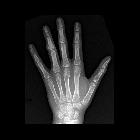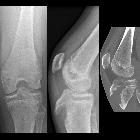Salter-Harris type IV fracture



Salter-Harris type IV fractures are relatively uncommon injuries that occur in children. They are intra-articular injuries in which the fracture extends through the epiphysis, across the physis and through the metaphysis. Salter-Harris fractures are a group childhood injuries where a fracture involves the physis.
Salter-Harris IV injuries typically have a poor prognosis due to interruption of the proliferative and reserve cartilage zones often leading to altered joint mechanics and functional impairment and as such orthopedic evaluation and subsequent operative intervention are often required .
Epidemiology
Approximately 10-12% of all physeal fractures will be a Salter-Harris type IV fracture. Salter-Harris type IV injuries will often follow typical location patterns and most commonly involve the distal radius, phalanges and distal tibia.
Radiographic features
Plain radiograph
- lucent fracture line extending through metaphysis, across physis and into the epiphysis
- angulation, displacement and rotation may occur
- adjacent soft tissue swelling and joint effusion may be noted
CT
CT may be helpful to further assess the nature of the fracture. This is particularly helpful in the distal tibia when the plain film can under-estimate the complexity and severity of a distal tibial injury.
- CT imaging has a role in evaluating the degree of displacement and anatomic extent of Salter-Harris type IV fractures and can subsequently guide operative intervention
- CT imaging can also be incorporated to evaluate focal osseous bridging across the physis during the healing process (most common in Salter-Harris IV and V injuries)
Siehe auch:


 Assoziationen und Differentialdiagnosen zu
Assoziationen und Differentialdiagnosen zu 

